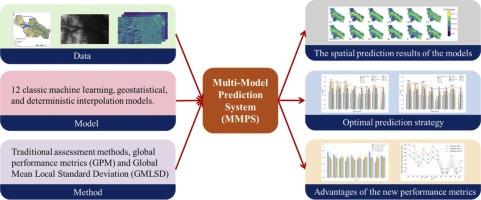土壤镉浓度空间预测:一种具有新评价指标的多模型预测系统
IF 11.3
1区 环境科学与生态学
Q1 ENGINEERING, ENVIRONMENTAL
引用次数: 0
摘要
本文提出了一种模块化、自动化的多模型预测系统(MMPS),以克服小样本条件下土壤镉(Cd)空间预测中的非线性关系、数据集成困难和模型不稳定性。我们进一步引入了两种新的评估指标——用于评估跨运行稳健性的全局性能指标(GPM)和量化预测图空间稳定性的全局平均局部标准偏差(GMLSD)。该系统具有较高的预测精度,其中LGBM模型表现出较好的性能(全局R²= 0.614)。至关重要的是,GPM产生了更加一致的评估,与传统指标相比,随机种子的性能标准差降低了88.6%。MMPS集成了地质统计学、确定性和机器学习算法,在中国湖南的一个小矿区流域进行了测试。利用来自149个样本的多源数据(遥感、地形、土壤性质),我们比较了12种模型。结果表明,机器学习模型的预测精度较高,但空间预测稳定性较低(GMLSD较高)。地形数据是最具影响力的输入,将性能提高了53.5%,而光谱或土壤数据本身的影响有限。与河流的距离、土壤pH值、B2带和有机质为主要驱动因子。MMPS为污染管理提供了高精度、低成本的智能工具。结合我们强大的评估框架,该研究为环境空间预测提供了一个新的范例,从而实现更智能、可扩展和更可靠的污染控制策略。本文章由计算机程序翻译,如有差异,请以英文原文为准。

Spatial prediction of soil cadmium concentration: a multi-model prediction system with novel evaluation metrics
This study proposes a modular, automated Multi-Model Prediction System (MMPS) to overcome nonlinear relationships, data integration difficulties, and model instability in soil cadmium (Cd) spatial prediction under small sample conditions. We further introduce two novel evaluation metrics — Global Performance Metrics (GPM) to assess robustness across runs, and Global Mean Local Standard Deviation (GMLSD) to quantify spatial stability of prediction maps. Our system achieved high predictive accuracy, with the LGBM model demonstrating superior performance (Global R² = 0.614). Crucially, GPM yielded substantially more consistent evaluations, exhibiting up to an 88.6% reduction in performance standard deviation across random seeds compared to traditional metrics. The MMPS, which integrates geostatistical, deterministic, and machine learning algorithms, was tested in a small mining watershed in Hunan, China. Using multi-source data (remote sensing, topography, soil properties) from 149 samples, we compared 12 models. Results showed that machine learning models achieved higher prediction accuracy but tended to have lower spatial prediction stability (higher GMLSD). Topographic data was the most influential input, boosting performance by 53.5%, whereas spectral or soil data alone showed limited impact. Key driving factors were identified as distance to river, soil pH, B2 band, and organic matter. The MMPS provides a high-precision, low-cost intelligent tool for pollution management. Together with our robust evaluation framework, this research offers a new paradigm for environmental spatial prediction, enabling smarter, scalable, and more reliable pollution control strategies.
求助全文
通过发布文献求助,成功后即可免费获取论文全文。
去求助
来源期刊

Journal of Hazardous Materials
工程技术-工程:环境
CiteScore
25.40
自引率
5.90%
发文量
3059
审稿时长
58 days
期刊介绍:
The Journal of Hazardous Materials serves as a global platform for promoting cutting-edge research in the field of Environmental Science and Engineering. Our publication features a wide range of articles, including full-length research papers, review articles, and perspectives, with the aim of enhancing our understanding of the dangers and risks associated with various materials concerning public health and the environment. It is important to note that the term "environmental contaminants" refers specifically to substances that pose hazardous effects through contamination, while excluding those that do not have such impacts on the environment or human health. Moreover, we emphasize the distinction between wastes and hazardous materials in order to provide further clarity on the scope of the journal. We have a keen interest in exploring specific compounds and microbial agents that have adverse effects on the environment.
 求助内容:
求助内容: 应助结果提醒方式:
应助结果提醒方式:


